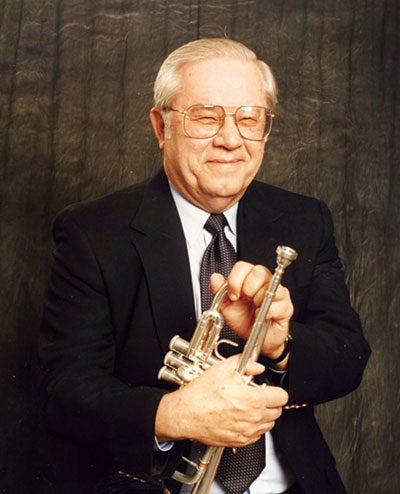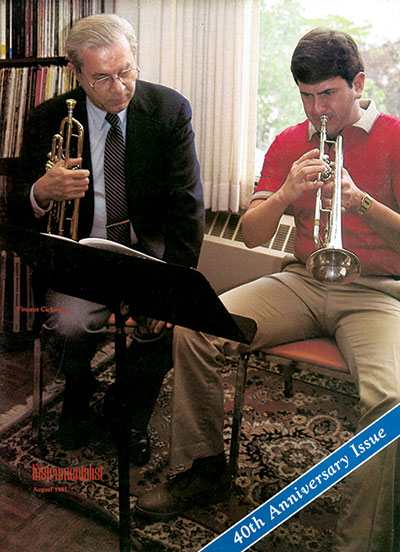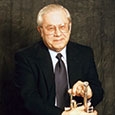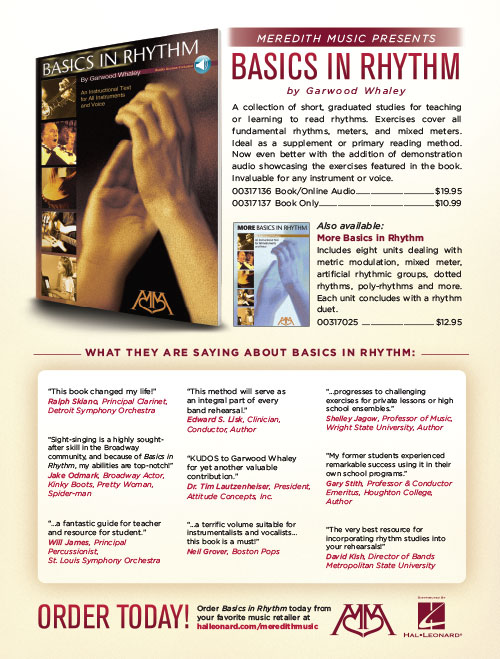 Musical Image
Musical Image
Although playing an instrument is a complex activity, too often teachers focus on the complexities instead of finding those directions that simplify the messages to guide students to the best solutions. Without a musical image in your mind, the difficulties of performing on an instrument are magnified greatly. Many of us assume that students have a good musical image, but I am amazed at how often this basic element is either absent or fades into the background. Everyone is concerned about respiration, embouchure, and tonguing as separate entities, but it is the musical imagery that pulls this together. All of the component parts of playing are merged by the aesthetic message guiding them. If the musical thought you want to convey is clear in
your mind the result will be reflected in the appropriate application of the techniques required to achieve your goal. I always put this concern at the top of the list. Even with young students just hearing a good sound is the beginning of aesthetic thought. If we instill and demonstrate a good basic sound, we will have set them on the correct path. I have a long shelf of books on how to play the trumpet. Most contain valuable information, but many of the specific directions are too highly personalized and complicated to be of much use. By stressing the musical goal we can avoid some of the more torturous descriptions of the requisite physical actions.
Respiration
Respiration is a simple, essential activity that everyone does without being taught. Almost every person who picks up an instrument alters this basic function. A trumpet player who wants to play a high note stiffens the body in preparation for this formidable task. The act of breathing is no longer simple or natural, as it would be for a sigh or a yawn. The habit of taking a correct breath is extraordinarily important. It should be consistent under any circumstances. Breathing should be a part of making music. A recording of a fine singer will capture his breathing. It will always be clear and without any hissy sound. The first step is a yawn or a sigh that inhales a full, deep breath. The size of the breath may vary to fit the phrase, but the character of the breath should remain consistent. The other part of respiration is blowing the air out, and this too should be a simple, almost instinctive behavior. To blow out a candle takes one kind of airstream, but to just make the flame flicker takes a more gentle airstream, which exemplifies the flexibility necessary to play softly.
When faced with a difficult passage, players often change the natural process of breathing and blowing, which creates problems with tone, range, and articulation. The basic rule is simple: always blow the same way. Music notation is vertical as notes are high or low, but the airstream should be fundamentally the same regardless of pitch. A violinist draws the bow back and forth essentially the same way regardless of whether playing high on the E string or low on the G string. On a trumpet, sound is produced as air moves across the lips and moves through a little hole in the mouthpiece in a horizontal fashion. The process of moving air through the trumpet should be the same regardless of the pitch played.
When playing in the high register many players stiffen the body, which restricts the natural process of breathing and blowing. Too much emphasis on abdominal support tends to tighten the abdomen; the result is that many players lock the breath in a muscular action that physiologists call the Valsalva maneuver. Valsalva is a natural function in excretion, childbirth, and lifting heavy objects, but it impedes trumpet playing by constricting the breath. It is sometimes difficult to tell the difference between the sensation of playing fortissimo in the upper register and the tension of the Valsalva maneuver. The key is to avoid locking the air in before playing because this makes it impossible to move a significant amount of air freely. By starting a phrase with the intensity and force to play in the upper register, the abdominal firmness here results from doing the work rather than from superimposed tension before playing. This is probably the most significant distinction for brass players to learn. Many problems that are commonly diagnosed as tonguing, flexibility, endurance, or range deficiencies are traceable to some distortion in the area of tone production.
I recommend practicing wind patterns away from the trumpet to be free from the inhibitions and worries that often become bad habits when playing the instrument. These wind patterns should be executed by forming the mouth as if preparing to play the instrument, taking a full breath, and blowing the musical pattern with the wind and articulation only.

This should be done without the instrument or mouthpiece and without buzzing the lips; the articulation should divide the wind stream, not interrupt it. When the body has no fear of playing poorly, the wind patterns are free and effective because it is usually difficult to make a mistake. By playing the opening movement of the Haydn concerto using only wind patterns without a trumpet, there is no sound and consequently there are no bad notes. Put a piece of paper in front of your mouth and see that the wind moves the paper energetically, although it feels almost effortless. In contrast, if you lock the air down, the paper barely moves and the abdominal area solidifies in a state of isometric tension, which means you are wasting 50% or more of your effort.
One miscalculated breath can spoil a whole phrase or even more, so it is important to decide where to breathe; then practice taking breaths there with the same neutral quality you would use for a simple phrase and not as if a high C is coming. Even though the intensity of effort and the energy expended is much greater in the high register, the fundamental technique stays the same. If the body becomes a kind of fake embouchure and puckers up for high notes, the breathing process becomes ineffective at the very moment you need it the most. Especially when a trumpeter becomes nervous, it is important to guard against packing down the breath. Train your body to respond in a certain way and never allow it to change.
Articulation
Another technique to simplify is articulation, which is nothing but language. Children learn to speak without any idea of how they manipulate their tongue and lips. When we pronounce the syllable tu there is a specific place where the tongue strikes the teeth, and in almost every instance that is the ideal place to tongue when playing. There is no reason to complicate the issue and increase a performer’s self-consciousness by training a skill that is already naturally in place. Articulation is simple as long as it is approached through language, but it is not easy. Articulation takes work, patience, and discipline.
The French school of playing exhibits some of the best qualities of articulation in the world, but it would be a mistake to have students who speak American English use the French tyu because that sound is not a normal part of their pronunciation. If you hear a good staccato and pronounce the syllable tu properly, you will get a wonderful staccato because tonguing is basically language: whichever consonant fits the style of the music plus the vowel are factors that affect the substance of the sound. Enunciation of the consonant ensures a tongue stroke in the desired style and clarity of attack; the vowel keeps the wind flow open to support the sound.
Multiple tonguing works the same way, but the second syllable should not be produced too far back in the mouth. Some books on my shelf advocate using a ku sound that is coughed into the instrument. How gross and ugly a k would sound when produced that far back in the mouth. A ku should be produced on the palate and not be guttural, so the farther forward you keep it the more effective the double- and triple-tonguing will be.
Guard against overdependence on the tongue for starting the tone; too much tongue produces a percussive sound. It helps to think of the trumpet as more like the violin; except for avant-garde effects, or col legno, violinists do not bang the bow against the string, they draw it. The musical ideal is to produce a pure sound right from the beginning, without any pop or sting to the note. Then it is possible to change the character of the articulation to fit the musical context. With an accent or sforzato more attack sound is desirable, but the ability to start cleanly and without accent is a great musical asset. It is especially important to avoid hard attacks when warming up.
To emulate the violin attack, practice just blowing, without the trumpet or mouthpiece, and without forcing, pushing, or pressing; just let the wind flow. Then take the instrument and match this effect as closely as possible. If you chop at a note or interrupt the airflow, this invites a cracked note. Listen for which notes sound like violin strokes and which are more like timpani strokes; the notes you slap at are likely to break.
I know of no effective pedagogy to teach flutter-tonguing. As with all articulations this is a matter of language, in this case a rolled r. Some players trill the r easily, but for others it seems impossible. The difficulty stems from the fact that American English does not use a rolled r, so it is a movement to be learned specifically for the instrument. Recent pedagogical literature suggests that some people are genetically unable to flutter-tongue, but I suspect that native Italian, Spanish, or German speakers, who have the trilled r in their language, have little difficulty with flutter-tonguing.
Embouchure
Teachers often give direct instructions for wind and articulation, but descriptions of embouchure activity are usually vague and highly individual. The embouchure is much like vocal cords; training comes from use. By combining good musical standards, healthy breath support, and appropriate practice materials, the embouchure develops almost autonomously, with little direction. The practice of studying your embouchure in front of a mirror is seldom helpful and often is frustrating or discouraging. A cloudy tone is not caused by a poor embouchure but may be the result of pressing the air out, which causes the higher overtones to disappear. Instead of a wonderful dark sound, the notes sound pinched or dull. As the air is freed up, the sound becomes livelier and more colorful.
 Practicing
Practicing
I don’t believe there is only one effective way to warm up, but I am suspicious of using glissandos, because they do not zero in on anything specific. Glissandos may loosen things up and get a little flexibility going, but that is possible with exercises that have a more practical musical application. Take a big breath before each pattern, and even on mouthpiece buzzing try for musical effect. Listen to what is good or not so good with the sound. I strongly recommend blowing wind patterns away from the instrument, using lots of breath. With wind patterns there are no inhibitions; it is easy, natural, and the body functions in a more normal manner. The trick is to reproduce this effect and feeling on the instrument.
To overcome tension in the high register or when playing piccolo trumpet, always start at a secure point. For students preparing to play the second Brandenburg Concerto I have worked out a routine that I call the "Brandenburg Project." Students begin this extraordinarily difficult and physically demanding piece on B flat trumpet while reading from the piccolo notation but playing down an octave so there is little or no anxiety. We work through the technique meticulously and then do the same thing on a C trumpet. As the level of difficulty increases, the idea is to maintain a stable execution. We then go to the higher trumpets and at some point, usually on the E flat or F trumpet, students start to scrunch down a little until I remind them to maintain the same technique as before. The act of going through the project will gradually increase their strength as long as they do not change the basic technique. It takes more energy to play high, but this should not introduce inappropriate tension. The system works if enough time is taken to develop consistent responses. The best method to introduce the piccolo trumpet is to start on a lower trumpet with the piccolo notation and gradually progress into the upper register without relying on any additional physical force. Energy, yes, but not force.
Choose a tempo for practicing at which you can control the sound without it sounding as if you are target shooting. When the tempo is too fast, the music sounds crowded and nervous. Choose a tempo that establishes the brilliance of the piece but also allows a certain ease of technique.
Both tone and intonation are dependent on the player’s musical concept and his use of the breath. Thinness of tone often comes from body tension in anticipation of a high note. Many players seem to exist only for the high notes, but having spent a large part of my life as a second trumpet player, I have grown inordinately fond of low notes. The idea here is to retain the vocal quality, and even if the dynamic is soft to keep the sound interesting. Do not skimp on the breath; use a big yawn. In any range if the musical concept is strong and the wind is free, it is amazing how the ear guides all of the small adjustments that produce good intonation.
People ask how I teach vibrato, but I have never taught it. I have never come across a student who plays with an absolutely dead, straight sound with no inflection of any sort. Such mechanical procedures as vibrating a particular number of waves per minute often sound like Hammond organs to me and are useless. Trumpet players should listen to singers and other good brass players and try to emulate their sound. I usually have students sing to learn about their natural inclination for nuances and then encourage them to imitate their voice as best they can. Demonstration is also helpful. However, after teaching trumpet for over 30 years I have found no specific pedagogy for teaching specific types of tone or vibrato. I always come back to the basic concept of aesthetics, to how the person hears tone or vibrato.
I try to let students alone as much as possible and not produce carbon copies. Of a large number of successful students, all have developed individual characteristics in their playing. Individuals should cultivate their own aesthetic, their own personality; that is much more musically gratifying, much more artistically satisfying.


.jpg)




